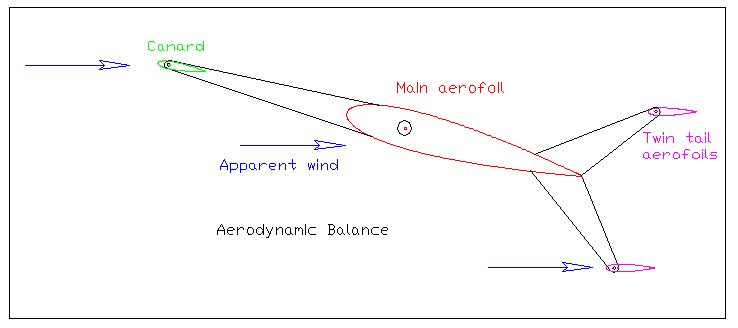The general concept of using a canards to control the angle of attack ( AOA ) of the main aerofoils remains but the control is slightly different to that which was previously described:

The pivot of the main aerofoil is slightly forward of the nominal centre of pressure ( 1/4 chord position ).
The Canard is mounted on the support connecting it to the main aerofoil. It pivots forward of its centre of pressure and is connected to the shaft about which the main aerofoil pivots such that its chord remains constantly tangential to the giant circle about which the aerofoils rotate. In a similar manner to the original concept, this connection has an elastic ( spring )section which allows the canard to rotate to reduce its AOA to the apparent wind when the wind velocity at the AOA exceeds a design limit allowing the canard to feather in incremental steps as the apparent wind velocity increases.
For winds within the design rating the AOA on the canard is the angle of the apparent wind to the tangential velocity. The aerodynamic load on the canards results in the main aerofoils rotating to create a balancing torque with an AOA that can be greater than the AOA on the canard. Previously the AOA on the main aerofoil was smaller than that of the canard, but it was independent of the angle of the apparent wind to the tangential velocity.
Twin tail aerofoils are also mounted on the rear of the main aerofoil. They are also pivoted forward of their centre of pressures. They can rotate freely ( only damped ) up to a design angle each way but do not rotate beyond that angle. The AOA on these tail aerofoils will be”zero” or the AOA on the main aerofoil less the associated design angle of freedom of rotation. The twin tail aerofoils thus limit the AOA of the main aerofoil
The advantage of this approach is that construction for marine use can be simplified: A neutrally buoyant submerged ring structure is connected to the central floating generating hub, which is tethered to secure its location. Each main aerofoil can be joined to the submerged ring structure, via its own large floating platform and large universal joint, such that they can each freely rotate and rock with waves about these joints. Non rotating shafts up from these joints enables simple links to the canards. These links can include dog clutches for complete feathering for any maintenance. Because the platforms can rotate the stays can be secured to fixed locations, removing the need for tracks, or turn tables.
The output from a VAWT based on this approach will be greater than that of fixed aerofoils due to the increased AOA of the apparent wind on the main aerofoils at design wind speeds. The system also retains the capability of feathering to safely harness energy from extreme winds